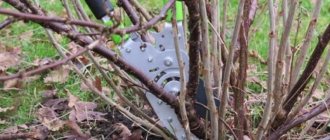How to understand that a peony needs feeding
Peonies are usually fed 2-3 times a year.
In summer, peonies release all the nutrients from the roots to build up green mass and lush flower caps. Therefore, by autumn the plant is completely depleted. The following signs indicate that the peony urgently needs feeding:
- short flowering;
- pale leaves;
- flowers that become smaller every season.
Before wintering, the peony is fed even if outwardly it looks healthy and full of strength. Fertilizer will protect the plant from the cold, and in the spring it will help it develop large buds.
The flowering period of peonies is up to 20 days.
Care
First of all, you should pay attention to pruning peonies. The most common and insidious mistake is cutting off peonies at the root in the summer, immediately after flowering. Early pruning may prevent flowering the following year. The fact is that a faded peony lives an active life; important processes take place inside the plant, namely the laying of renewal buds for the next year.
Buds form on peony roots. New stems will grow from them in the spring. To grow buds, a peony requires a lot of vitality and nutrients. And they reach the root through the stem and green mass. A peony without a stem and greenery is deprived of nutrition. That is why you absolutely cannot prune a peony immediately after flowering, in the summer. It is recommended to do this as late as possible, almost before the frosts: in September - early October. It is convenient to trim with pruning shears, leaving a stump literally 2-3 cm high at the bottom. And in the summer, immediately after flowering, it is enough to simply remove the faded flowers so that the petals do not cause gray rot.
Autumn is also the best time to divide and transplant a bush to a new location. But this is a topic for another conversation, and we move on to feeding.
Types of fertilizers for autumn feeding of peonies
Organic and potassium-phosphorus fertilizers are suitable for any type of soil
As a rule, mineral or organic fertilizers are used to feed peonies. For complete nutrition, they are used together in 2 stages:
- Before pruning peonies (early September), a mineral composition is added.
- After pruning, plant or animal organic matter is added.
Some gardeners prefer to use folk remedies. They are no less effective than store-bought drugs.
Mineral
The following fertilizers are suitable for autumn feeding:
- superphosphate - 25–30 g;
- potassium sulfate - 15–20 g;
- potassium monophosphate - 45–50 g;
- potassium magnesia – 15–20 g.
The proposed dosage is used per 1 square meter of soil. If you cannot find such preparations, you can mix two main ingredients - potassium and phosphorus. There will be enough of them to feed the peonies.
In autumn, nitrogen fertilizers cannot be used, as they provoke the development of green mass. The peony will spend the energy needed to prepare for winter on growth, as a result of which it will weaken and risk dying in the winter.
Organic
The following are used as organic fertilizers:
- wood ash - no more than 200 g per bush (poured under the peony in the form of an aqueous solution or scattered around the stems);
- bone meal - no more than 150 g per bush (scattered on the ground and dug in);
- compost or humus - about 8 kg per bush (mulch the soil under the plant).
Folk remedies
Gardeners who oppose chemical fertilizers feed peonies with folk remedies:
- coffee grounds - 150 ml per bush;
- tea leaves - 100 g per bush;
- banana flour - the peel of 2-3 fruits is crushed and scattered around the peony trunk;
- shells of 20 eggs - fill it with a bucket of water and leave for 2-3 days, after which 0.5 liters of infusion are poured under a peony bush;
- rye infusion - crush a loaf of bread and pour it into 10 liters of water for 12 hours, use 1 liter of product per plant.
Folk recipes
How many useful things nature has prepared for better flower growth. If you are not a chemistry buff, then the opportunity to use what is always at hand may really appeal to you. Folk recipes for caring for peonies are simple and accessible. And at the same time highly effective. So, what can you use to successfully breed peonies?
Coffee grounds
Many people pour it under indoor plants. It will also bring a lot of benefits to peonies. Improves growth and protects against fungi. You can collect the leftovers in just a couple of weeks. This amount is enough to fertilize the bed.
Tea brewing and other benefits
We operate on the principle: whatever we don’t drink, we add to the soil. Tea leaves - tea tree leaves will especially appeal to peony. You can collect banana peels, which contain a lot of potassium. Onion peels can also turn into valuable fertilizer in the hands of a caring owner. Egg shells are useful for making insanely healthy calcium water. Shells need to be collected from 20 eggs.
To do this, the shells are placed at the bottom of the bucket and filled with water. After three days, the perfect calcium fertilizer is ready.
Ways to feed peonies
For sandstones and depleted soils, fertilizing is applied 2 times with a mandatory interval of 2 weeks.
The most suitable time for autumn feeding of peonies is from mid-September to mid-October. Deadlines may vary depending on region. The main rule that should be followed is that the work must be completed 1–1.5 months before the first frost. Fertilizers can be applied in three ways: at the root, foliar, or in the holes during transplantation.
Prikornevoy
This is the most suitable method for autumn feeding. Fertilizer is placed under the root in one of two ways:
- Dry. Mineral granules or dry organic fertilizers are scattered around the trunk onto moist soil.
- In liquid form. The vitamin composition is stirred in water, and then the plant is watered with it.
In cloudy weather, it is recommended to apply fertilizers using a dry method, otherwise the nutrient solution will be washed away by rainwater. If it is dry outside, preference is given to the liquid method.
Foliar
It involves spraying the peony with a nutrient solution. This method is used mainly in the spring, when the buds begin to bloom. In the fall, after flowering, you can spray the peony with microfertilizers (2 tablets per 10 liters of water). The procedure is carried out in the evening or in cloudy weather so that the leaves and trunk of the plant do not suffer from sunburn.
Into the hole
Peonies can develop well in the same place for 10–15 years, but sometimes they still have to be replanted. If the procedure is planned for autumn, you can supplement the process with fertilizer in the hole. To do this, the bottom of the hole dug for the plant is covered with a mixture of humus and bone meal.
Condition 3. Prepare for winter
Feeding peonies with fertilizers in the fall is just one of the stages in preparing plants for winter. After pruning it will not be superfluous to:
- loosen the soil around the bushes;
- remove weeds;
- sprinkle humus or mulch around in a layer of about 15 cm;
- Before mulching, it is useful to sprinkle the soil around the peonies with a mixture of bone meal and ash, mixed in equal parts.
If the winter in your region has little snow or there is a risk of snow blowing out of the peony bed, it is better to cover the plants for the winter with a special covering material or spruce branches. This will prevent the peony bushes from freezing
Feeding an adult and young peony: what is the difference
The older the peony, the smaller the buds
The age of the plant significantly influences the principles of autumn feeding. So, a peony under three years old should not be fertilized - it receives the necessary nutrients from the soil. A young plant may die if you feed it without good reason. With adult peonies, the opposite is true: the older the flower, the more nutrition it requires.
How to grow lush peonies
The development of the root system of peonies continues even after active flowering.
To grow large, bright peonies, experienced gardeners recommend:
- At the end of September, water the plants with potassium chloride, and in early spring feed them with a solution of manure.
- For organic animal matter, choose bird droppings rather than cow droppings. It contains much more nutrients.
- Focus on fertilizing with bone meal if peonies grow in wetlands. This fertilizer neutralizes high acidity and also supplies the soil with calcium and phosphorus.
- Be sure to trim the stems of peonies and cover the rhizomes before wintering. During the cold season, plants become vulnerable and may not survive without insulation. Cut branches are burned to avoid possible proliferation of parasites.
- Every 8–10 years, divide and replant the bushes. The older the plant, the smaller the buds on it will be. The transplant procedure is carried out at the end of August.
Reviews from flower growers
I feed mine with “Solution”. 1 bag for 2 watering cans (8 l each) per bush.
imers
https://www.websad.ru/archdis.php?code=4538&subrub=%CF%E8%EE%ED%FB
In autumn, superphosphate and potassium sulfate. I don’t remember exactly, but it seems that the consumption per bucket of water is one tablespoon.
Natalya_Filatova
https://7dach.ru/NatashaK/podskazhite-chem-luchshe-podkormit-piony-osenyu-90602.html
During the summer period, I feed with mullein solution, but I feed this solution only until July. Throughout the entire summer period, I soak the leftover bread and add this solution to each bush. In the fall, in October, I prepare the bush for wintering. I cut off the stems and leaves and sprinkle it under the bushes potassium and phosphorus fertilizer.
Miluda
https://forum.say7.info/topic79830.html
Other procedures: watering, transplanting, disease prevention and treatment
You can water peonies after autumn pruning, but not too much, especially for ITO varieties.
If the bushes have grown a lot, they should be replanted. This procedure must be carried out during the velvet season (late August - first half of September), when the weather is warm, dry. The peony will get used to the new place, take root and quickly grow in the spring.
In spring and summer, it is better not to plant or replant the peony - all the plant’s energies are aimed at flowering and producing seeds, so the risk of death is very high.
Whatever feeding method you choose, you need to apply fertilizer very carefully so that the additives do not get on the root neck of the peonies.
How to properly plant peonies in the fall:
- Choose fertile, loose soil, preferably black fallow (an area that has been “resting” for a year) or land on which legumes have previously grown. The landing site should be sunny, not windy, away from buildings and trees.
- 4 weeks before planting, dig ditches with a diameter and depth of up to 0.5 m, at a distance of 1–1.5 m from each other. Place drainage at the bottom: sand, gravel and water to settle the soil.
- Mix chernozem with humus, sand, manure, peat and ash in a 1:1 ratio. Pour the mixture into the hole and mix with garden soil. You can also add urea, superphosphate, and ferrous sulfate.
- Trim the peony stems to 15 cm. Carefully dig up the old bush. Shake off the soil and leave the dug bush in the shade for 2 hours so that the roots are not brittle.
- Inspect them, remove damaged and dried ones. Cut large ones at an angle of 45–60º, leaving a length of 10–20 cm. Sprinkle the sections with crushed charcoal. Place the roots for half an hour in a light pink solution of potassium permanganate.
- After soaking, plant young peonies in separate holes, placing the buds at a depth of 4–5 cm from the surface. Each division should have 2–3 shoots, 3–4 roots and growth buds.
The most gentle method of dividing a dug up bush is to plant it on a 40–50 cm stake. The bush will spontaneously disintegrate into the required sections.
Video: How to feed peonies in the fall
Autumn fertilization of peonies is an important and very effective procedure. Complete and balanced nutrition of the roots will allow plants to develop properly. Peonies that receive enough care in the fall will certainly delight the owner with luxurious large buds and long-lasting flowering.
- Author: JuliaKurb
Rate this article:
- 5
- 4
- 3
- 2
- 1
(1 vote, average: 5 out of 5)
Share with your friends!











